The figure of Goddess Britannia is familiar to everybody, a female personification of the island of Great Britain. The martial Britannia was used as an emblem of British imperial power and unity. Goddess Britannia also featured on the banknotes issued by the Bank of England and on the reverse of the penny.
History and Origin:
Britannia was the Greek and Roman term for the geographical region of Great Britain which was inhabited by the Britons. The term Britannia is a Latin word derived from the Greek ‘Prettanike’ or ‘Brettaniai’ used to denote a collection of islands with separate individual names.
However by the 1st century BC, Britannia came to be used for Great Britain specifically.
The history of Britannia can be traced back to the Roman times when in 43 AD Claudius directed four legions to conquest Britain and reclaimed an empire over the Atrebates (a Belgic tribe of Gaul and Britain). This newly reclaimed province was called as “Britannia”. The region, however, was first invaded by Julius Caesar in 55 BC.
Later in the 2nd century, this roman Britannia came to be personified as a female goddess “Britannia” and her iconographic attributes consisted of a trident and a shield and was shown wearing a Corinthian style helmet.
The Latin name “Britannia” stayed with the region long after the Roman withdrawal from Britain. After centuries of declining use, the Latin form was revived during the English Renaissance and the name along with its personification became a symbol of British national identity.
Following the Acts of Union in 1707, the Kingdoms of England and Scotland unanimously adopted Britannia as an emblem of British imperial power and unity.
Britannia on Roman coins:
Hadrian’s Britannia:
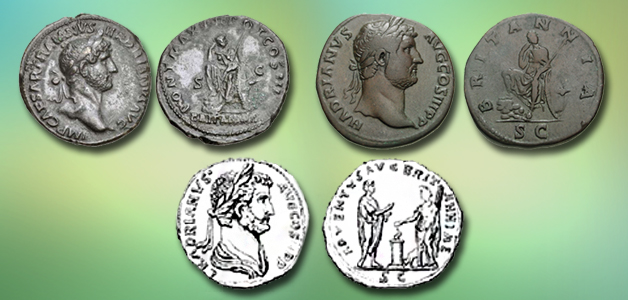
- Britannia first appears on Emperor Hadrian’s coins. In A.D. 122 Emperor Hadrian visited Britain and coins were struck commemorating this visit.
- A circa A.D. 134 to 138 bronze sestertius struck at the Rome Mint depicts on the obverse a diademed bust of the Emperor looking right and the reverse depicts Britannia seated resting her feet on rocks.
- Between A.D. 134-138 sestertii and dupondii or asses again depicting Britannia were struck by Emperor Hadrian. Some of these issues are extremely rare and they refer specifically to his arrival in Britain (ADVENTVS AVG BRITANNIAE) or his inspection of the army in Britain (EXERCITVS BRITANNICVS).
Antoninius Pius’s Britannia:
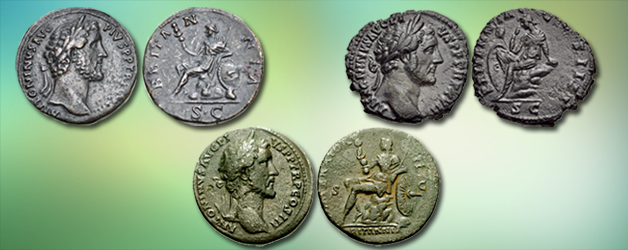
- Britannia coins were repeated by Hadrian’s successor Antoninius Pius. Gold and bronze coins with the reverse legend IMPERATOR II BRITAN were struck with either Britannia or a winged figure of Victory on them.
- The coins struck by Antoninius Pius are said to be the iconographic prototype of the Britannia figure which was used 1300 years later on British coins.
- The coins show a slightly different image of Britannia on them. Some show her seated left on a heap of rocks, holding signum in right hand and cradling spear in left arm, leaning on round shield set on helmet. While the other image shows Britannia seated left on rock, propping head on hand and another hand on a rock, in an attitude of mourning; shield and eagle-protome sceptre to left.
- Antoninus Pius struck another copper series of Britannia coins in 154 AD. These coins were poorly struck and commemorate more warfare. This 154 AD series of Britannia coins were probably struck as special donations (gift) for soldiers. The legend “BRITANNIA” on the reverse can be read quite clearly, starting at about 7 o’clock.
Other issues:

- Emperor Commodus also issued coins with BRITANNIA or VICT(oriae) BRIT(annicae)on them following the campaigns of Marcellus in 185 AD.[1]
The geographical personification of Britain must have been less popular with the emperors later because just twenty-five years after the Britannia strikes of Commodus in 184-185 AD the coins struck by the successors to commemorate their campaigns in Britain depicted the goddess of victory, Victoria.
- However coins issued by Septimius Severus, Caracalla and Geta feature on the reverse a possible female figure identical with Britannia standing on one side of the trophy and Victoria standing on the other with a captive seated below. Some coins also depict Victoria raising trophy and female figure possibly Britannia seated at her feet. [2]
- The Severans issued coins in gold, silver and bronze commemorating their campaign in Britain, all bearing the legend VICTORIAE BRITANNICAE in full or abbreviated, as well as adding the honorary title BRIT(annicus) to their name on the obverse.
- Later Carausius (286-93) also celebrated his military campaigns in Britain by striking some coins. One such special issue shows Britannia greeting him.
The Revival:
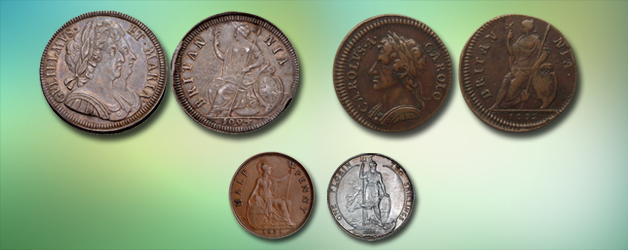
Nearly 13 centuries later Britannia was revived on coins. This image of Britannia was copied from the early Roman prototypes. During the reign of Charles II, Britannia made her first appearance on English coins on a farthing of 1672.
- However in 1665, a series of pattern farthing-sized medals was issued bearing the legend Quatuor Maria Vindico meaning ‘I claim the four seas’ around seated figure of Britannia.
- Since her revival in the 17th century, Britannia appears on halfpenny coins till 1936. Although halfpennies and farthings were not issued continuously from 1672, Britannia remained on the reverse on the coins even then. Under James II (1685-8) and William and Mary (1689—94) tin halfpennies and farthings were issued.
- The image of Britannia has undergone slight changes since its revival and in the cartwheel pennies and two pence of 1797 her spear has been replaced by a trident and she is shown seated on rocks in the sea, with a ship in the background.[3]
- Britannia under King George IV appeared on pennies, halfpennies and farthings but she now sat facing right instead of left, wearing a helmet. This right facing Britannia continued till 1967.
- Edward VII changed the design of Britannia further; she was shown standing up rather than sitting beside her shield. She appeared on two shilling (one florin) coins under Edward VII.
- After 1936, Britannia was permanently removed from the halfpennies and farthings. Britannia was replaced by a sailing ship. However, she remained on the pennies until 1967 and the special issue of 1970.
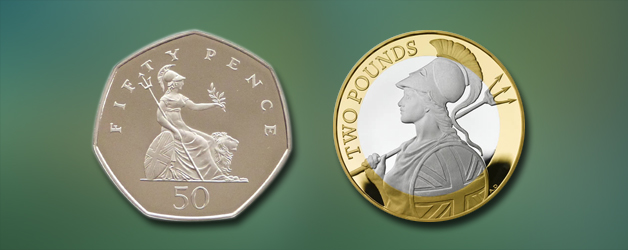
- The last Britannia penny was minted in 1970 and with the introduction of the decimal currency in 1971 Britannia appeared on the 50 pence coins until 2008.
- Further in 2008, the Royal Mint unveiled new coin designs which featured new Britannia image on them. Also, Britannia continues to appear on the gold and silver “Britannia” bullion coins issued annually by the Royal Mint.
- Then in 2015, a new definitive £2 coin was issued with a new image of Britannia.
Britannia on Stamps:
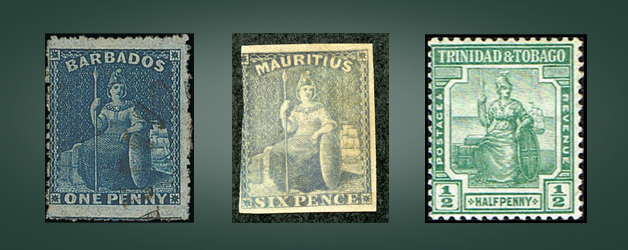
Britannia appears on postage stamps as early as 1850’s. Britain by now had a lot of colonies and since the advent of postage stamps in Britain, with the introduction of the ‘Black penny’, these colonies too had separate stamps issued.
- The British colony of Mauritius had Britannia on their stamps since the ‘Third issue’ of stamps in 1854.[4] These stamps depicted Britannia seated and were green in colour. However, these stamps had no face value on them. Since its introduction, the ‘Britannia seated’ stamps continued to be issued till 1863. These stamps came in different colours bearing different denominations of four pence, six pence, nine pence and one shilling.
- Barbados too has ‘Seated Britannia’ stamps. The earlier examples of Britannia stamps are the ‘green’ ones issued in 1854 with Barbados written the below and these too had no denomination printed on them. The stamps issued between 1852 and 1858 had no perforation around. These types of stamps are very rare to find.[5] Later four pence, six pence, one penny, half penny, five shillings and etc stamps were printed in different colours with Barbados written on the top.
- The colonies of Trinidad and Tobago also had similar Britannia stamps.
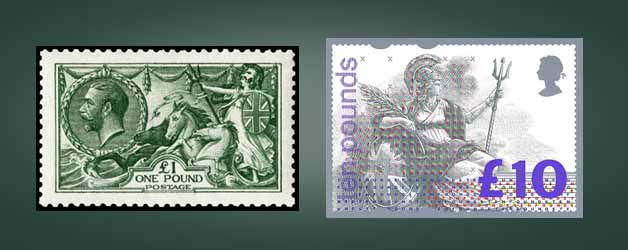
- In 1913, just a year before the outbreak of the First World War, the Anglo- German naval race was at its height and since his succession King George V issued a set of high-value stamps which could be used for international post. This new stamps showed Britannia on the waves with a sea horse. These new series was called as the “Sea Horse” series. The denominations of those being 2/6 half-crown, five shillings and ten shillings. Later these stamps were issued in pounds also.
- Britannia continues to be depicted on the £10 stamp since its first issue in 1993.
Britannia on Banknote:
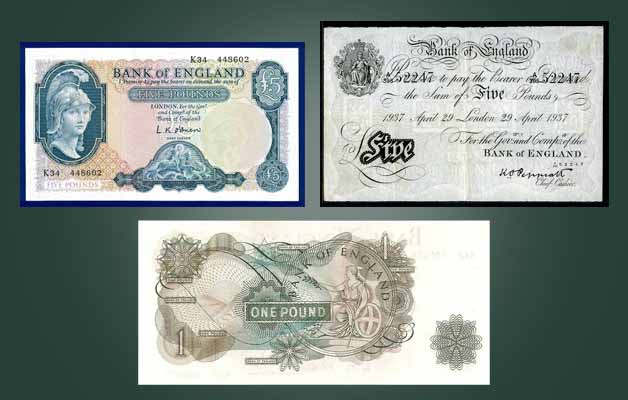
Britannia was depicted on the notes issued by the Bank of England. Britannia and the Bank of England are related right since the first few days of the establishment of the Bank of England.
On 27th July 1694 a Royal Charter from the king, William III was issued to form the Bank of England in order to raise funds for the government. This newly formed bank started to issue banknotes. These were handwritten and made out to an individual who could cash them at any branch of the issuing bank.
On the 30th July 1694, the Court of Directors decided that the device for their Common Seal should represent “Britannia sitting and looking on a Bank of mony”[6] And hence since then Britannia is the official emblem and logo of the Central Bank of Britain.
- The image of Britannia that appeared on the banknotes was slightly different than what was depicted on the coins and stamps so far. She was shown seated higher, facing in the opposite direction and had her bank of money-waist high.
- Britannia appeared on the “white fiver”, a five-pound note printed in black and white which was printed on one side only, from 1855 for more than a century, until 1957.
- From 1928 “Britannia Series A” ten shilling and one pound notes were printed with a seated Britannia bearing both a spear and an olive branch.
- From February 1957, a new series “Helmeted Britannia series B” was introduced. The lady Britannia was now depicted wearing a helmet. This series of notes were issued till 1963.
- Since 1964 when the Queen had given her permission to include her portrait on banknotes, the “Portrait Series C” appeared with a portrait of the HM Queen Elizabeth II instead of Britannia.
- A slightly different design of the “Portrait series C” has Britannia on the reverse of a 5-pound note with HM Queen Elizabeth’s portrait on the obverse.
- In March 2007, the first note from the New Series F entered circulation and now Britannia appears only in a 7mm sized circle tucked away in a corner with her rocks, branch, spear and shield.
Britannia, the female personification of the British Isles and the emblem of British imperial power, surfaces and resurfaces on coins, stamps and banknotes. She is also the symbol of the bank of England. Over the years, the image of Britannia has altered, and her maritime links being emphasised by switching her spear to a trident. Her name taken up by many companies and her connection with the sea has made Britannia a very popular name for the ships.
[1] Romano-British Coin Hoards, By Richard Anthony Abdy, pg.25
[2] The Hadrianic School: A Chapter in the History of Greek Art, By Jocelyn M. C. Toynbee, pg.64
[3] http://www.royalmint.com
[4] Mauritius Illustrated: Historical and Descriptive, Commercial and Industrial Facts, Figures and Resources, By Allister Macmillan, pg. 319
[5] http://www.barbadosstamps.co.uk
[6] http://www.bankofengland.co.uk/archive
The Mintage World Team comprises of experts, researchers and writers from the field of Philately, Notaphily and Numismatics who try to shed light on some of the most interesting aspects of coins, banknotes and stamps from not just India but across the globe as well.


A very interesting new site. I want to remain in touch regularly.